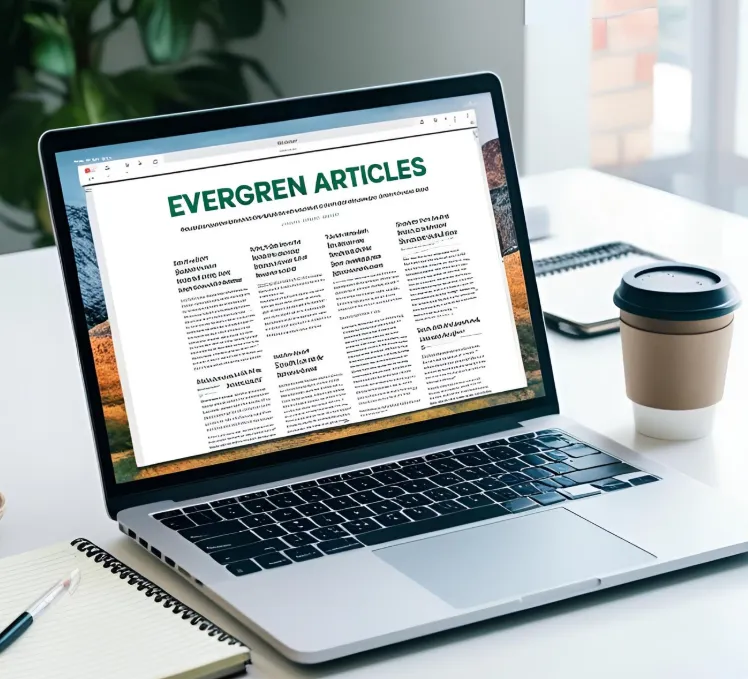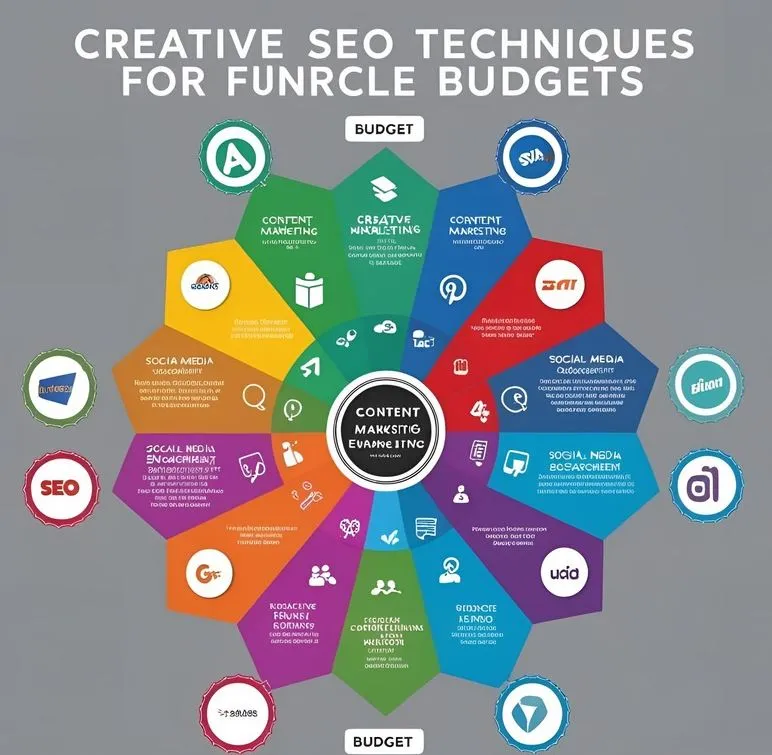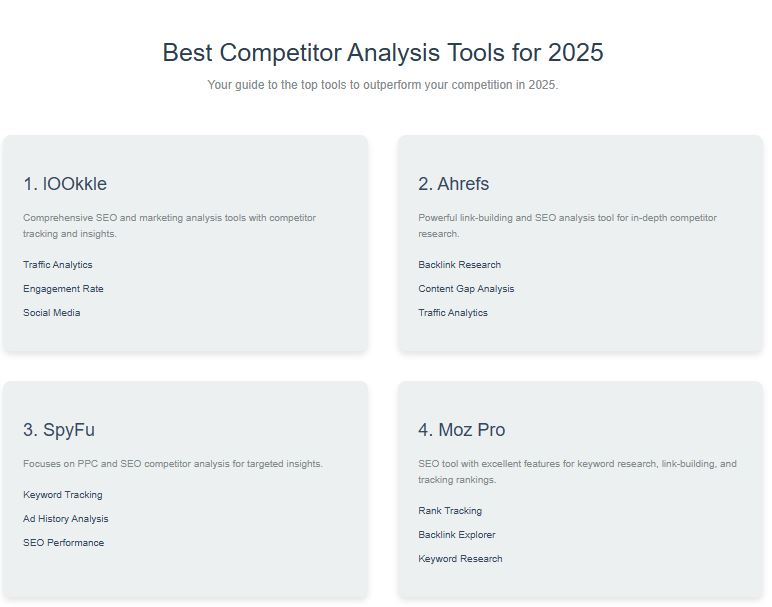
Few resources are as powerful and profitable in the world of digital marketing as an article that ranks well over time and is also well-written. This timeless content continues to attract organic traffic months or even years after its publication.
But how do you know what to write about? How do you find topics that truly endure?
That's where lookkle.com's SEO Site Explorer comes in. With it, you can discover content opportunities that consistently generate traffic and help you build a library of evergreen resources that continue to provide value.
What Is Evergreen Content?
Evergreen content is content that remains relevant, valuable, and useful over a long period of time. Just like evergreen trees that retain their leaves year-round, this type of content continues to perform and bring in organic traffic long after its publication.
Unlike news articles or trend-based posts that quickly become outdated, evergreen content answers timeless questions and addresses consistent needs.
Key characteristics of evergreen content:
-
It solves ongoing problems: Readers are always searching for practical, reliable solutions to recurring issues.
-
It targets consistent search demand: These topics have stable (or even growing) search volume month after month.
-
It’s not tied to a specific date or event: You won’t need to rewrite it every season or after every update—although occasional refreshes can help.
Why is evergreen content important for SEO?
-
Sustainable traffic: Once it ranks, it keeps bringing visitors with little maintenance.
-
Higher ROI: You invest once, and benefit continuously.
-
Link-building potential: Valuable, timeless content is more likely to be shared or cited over time.
-
Supports topical authority: Google rewards websites that cover fundamental subjects in-depth and consistently.
Examples of evergreen content:
| Topic | Why it’s Evergreen |
|---|---|
| How to optimize images for SEO | Websites always need to load fast and rank well—this won’t change. |
| Step-by-step guides to install Google Analytics | Every website owner, sooner or later, wants to track visitors. |
| Tips to improve website loading speed | Speed affects user experience and SEO at all times. |
| What is responsive design? | Mobile usability is a permanent concern across all industries. |
| How to write SEO-friendly blog posts | Writing for both humans and search engines is an ongoing need. |
What evergreen content is not:
-
“Top SEO trends for 2025”
-
“Black Friday deals this year”
-
“News on Google’s latest algorithm update”
These may bring short-term spikes in traffic, but they fade quickly. Evergreen content, on the other hand, is your long-term SEO asset.
Pro tip:
Even evergreen content can go stale if left completely untouched for years. A simple update every 6–12 months—refreshing links, data, or examples—keeps it relevant and can boost your rankings.
How to Find Evergreen Topics Using Site Explorer
1. Analyze Top Content from Competitors
Creating high-performing evergreen content starts with strategic topic discovery and SEO Site Explorer by lookkle.com makes that process efficient and data-driven.
Instead of guessing what to write about, you can analyze real competitor data to identify content that consistently brings in traffic. These are your evergreen opportunities.
The most powerful place to start is with your competition. Chances are, they’ve already published content that’s standing the test of time.
Steps to follow:
-
Enter a competitor’s domain into Site Explorer.
-
Go to the “Organic Keywords” section.
-
Sort by organic traffic.
-
Pay close attention to:
-
URLs with stable traffic over the last 6 months
-
Informational content, not product or seasonal pages
-
Article Titles with evergreen formats like:
-
“Ultimate Guide to…”
-
“How to…”
-
“X Tips for…”
-
“Beginner’s Guide to…”
-
-
-
Click on the top-performing URLs to review the actual topic and format.
If a page has been ranking well for more than 6 months, it’s a strong indicator that the topic is evergreen and the content structure is working.
What to Look For in Evergreen Candidates:
| Signal | Why it Matters |
|---|---|
| Stable traffic curve | Shows consistent interest, not tied to a trend or event. |
| Consistent ranking keywords | Suggests the topic is relevant long-term. |
| Evergreen intent | Content answers general, repeatable questions. |
| Informational or instructional tone | Helps users solve a problem or learn a skill. |
Pro Tip:
Check multiple competitors in your niche to find overlapping topics that consistently perform well across domains. That’s a strong sign the topic is evergreen and relevant to your audience.
Once you’ve identified a few solid topics, use Site Explorer to dig deeper into:
-
The keywords driving traffic to those articles
-
Backlinks pointing to them (which may help you plan your outreach)
-
Whether your own site already covers the topic (and how it performs)
Example Workflow:
Let’s say you run a digital marketing blog. You analyze a competitor and find their article:
"How to Optimize Images for Faster Page Load (Complete Guide)"
→ It gets consistent traffic, ranks for keywords like image SEO, reduce image size, optimize images for web
→ Published 2 years ago, still ranking top 3
→ That’s a proven evergreen topic
Now you can:
-
Write your own, better version with updated tools or tips
-
Target similar but untapped keywords
-
Use a unique angle, like image SEO for mobile-first design
2. Identify Keywords with Ongoing Demand
Site Explorer’s organic keywords section shows:
-
Monthly search volume
-
Keyword trends over time
-
The exact pages ranking for those terms
Filter for keywords that:
-
Don’t mention dates, years, or seasonal events
-
Have stable or growing search volume
-
Fit your audience’s long-term interests
3. Track Backlinks to Evergreen Content
Evergreen articles tend to earn natural backlinks over time. In the backlinks section of Site Explorer:
-
Find which competitor articles attract the most links
-
Check what type of content draws long-term attention
-
Use these insights to reverse-engineer link-worthy topics
Tips to Write Evergreen Articles That Rank
1. Make It Comprehensive
Evergreen articles should thoroughly satisfy the reader's search intent. The more complete and useful your content is, the more likely Google is to consider it authoritative.
How to do that:
-
Cover all key aspects of the topic (what it is, how it works, why it matters, how to use it).
-
Include examples, tools, templates, screenshots, or case studies where relevant.
-
Answer related questions that users often search for (use Google’s “People Also Ask” or keyword data from Site Explorer).
The more comprehensive your article, the longer users stay—and Google sees that as a ranking signal.
2. Avoid Time-Sensitive Wording
Even if your content is evergreen, certain phrases can make it feel outdated quickly. Avoid references that tie your content to a specific time frame unless you plan regular updates.
Avoid using:
-
Dates in titles like “in 2025” or “this year”.
-
Phrases like “recently,” “this week,” or “currently.”
-
Mentions of outdated tools or old software versions.
Instead, use:
-
Timeless titles: “Complete Guide to…”, “Best Practices for…”, “How to…”
-
Internal links to newer resources or updates.
-
A focus on core principles that don’t change often.
3. Optimize for On-Page SEO
Strong evergreen content also needs solid on-page SEO to rank and stay visible in search.
On-page optimization checklist:
-
Focus on one primary keyword, and use a few secondary keywords naturally.
-
Use clear, hierarchical headings (H1, H2, H3).
-
Structure content with bullet points, tables, or visuals to improve readability.
-
Add internal links to related posts or resources on your site.
-
Optimize all images (size, alt text, filenames).
SEO and user experience go hand in hand. Clean, readable content tends to rank better and convert more visitors.
4. Update Periodically
Even evergreen content needs occasional maintenance to stay competitive in the rankings.
Do a quick refresh every 6–12 months:
-
Update statistics, data, or examples.
-
Replace outdated links or add new tools and references.
-
Expand the content if you discover new subtopics or trends using Site Explorer.
Tips on SEO and Online Business
Next Articles
Previous Articles







